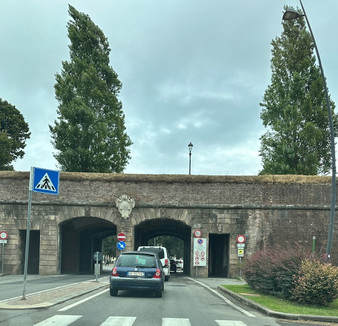Lucca Italy / Italia
- Maria Scuor
- Oct 8, 2024
- 11 min read
Italiano sotto ogni sezione
One of my favourite places in Italy is Lucca. We have been here four times now and every time is better than the last. Lucca is a city and municipality in Tuscany on the Serchio River and the city has about 90,000 inhabitants while the province of Lucca has about 384,000. It is known for its Renaissance-era city walls, preserved historic city center, Piazza dell’Anifiteatro and Guingi Tower.
Lucca was known as Luca with one “C” in the early Roman day. The Roman colony started in 180 BC and became a municipality in 89 BC. Julius Caesar, Pompey and Crassus reaffirmed their political alliances in Lucca in 56 BC with an informal alliance known as the First Triumvirate. Like all cities of importance in Italy, Lucca was besieged many times over.
Medieval legends state that The Holy Face of Lucca, a 2.4 m tall (8ft) ancient wood carving of Jesus, that currently is displayed in the Lucca Cathedral was supposedly carved by Nicodemus, who assisted St. Joseph of Arimathea in placing Christ in the tomb after the crucifixion. Same legends say that the carving arrived miraculously in Lucca in 782 AD. Radiocarbon dating confirms it to be dated between 770-880 AD.
Because of the Holy Face, the city was a major pilgrimage route to Rome from the north. It wasn’t until 1628 that Lucca managed as a democracy. This lasted until 1800 when French and Austrian armies fought over it. France prevailed and granted Lucca a democratic constitution in 1801, however in 1805, Napoleon installed his sister, Elisa Bonaparte Baciocchi as “Princess of Lucca”. Changing hands many times again, it wasn’t until 1861 that Lucca finally became part of the Italian State.
The walls of Lucca which are made of stone, brick and earthwork that surrounds the central city of Lucca. At 4 km and 223 meters in circumference, they are the second largest intact walls after Nicosia Cyprus. They were constructed between 1504 and 1648, with structural updates in the 17th century. The grandeur of the walls served as a deterrent and therefore protected the city from any wars.
The wall was converted to a pedestrian promenade and a public park in the 1820s under the rule of Maria Luisa de Borbón of Spain. The spaces outside the walls were converted to large lawns and the public use continues today, with the path above the walls heavily trafficked for recreation, and in the summer, it also acts as a stage for shows and events. It is a major tourist attraction of the city of Lucca.
FUN FACT: Lucca is known for it marble deposits and the west wing of the Ontario Legislative Assembly was rebuilt with Lucca marble after a fire in the 1900s.
We walked the inner streets of Lucca and here is a TikTok video and photos of this beautiful city - Abbiamo passeggiato per le vie interne di Lucca ed ecco un video TikTok e le foto di questa bellissima città
Uno dei miei posti preferiti in Italia è Lucca. Siamo stati qui quattro volte e ogni volta è meglio dell'ultima. Lucca è una città e un comune della Toscana sul fiume Serchio e la città conta circa 90.000 abitanti mentre la provincia di Lucca ne conta circa 384.000. È nota per la sua cinta muraria di epoca rinascimentale, il centro storico conservato, Piazza dell'Anifiteatro e la Torre Guingi.
Lucca era conosciuta come Luca con una "C" all'inizio dell'epoca romana. La colonia romana iniziò nel 180 a.C. e divenne municipio nell'89 a.C. Giulio Cesare, Pompeo e Crasso riaffermarono le loro alleanze politiche a Lucca nel 56 a.C. con un'alleanza informale nota come Primo Triumvirato. Come tutte le città importanti d'Italia, Lucca è stata assediata più volte.
Le leggende medievali affermano che Il Volto Santo di Lucca, un'antica scultura in legno di Gesù alta 2,4 m, che attualmente è esposta nella Cattedrale di Lucca, sarebbe stata scolpita da Nicodemo, che aiutò San Giuseppe d'Arimatea a deporre Cristo nella tomba dopo la crocifissione. Le stesse leggende dicono che l'intaglio arrivò miracolosamente a Lucca nel 782 d.C. La datazione al radiocarbonio conferma che è databile tra il 770 e l'880 d.C.
A causa del Volto Santo, la città era un'importante via di pellegrinaggio per Roma da nord. Fu solo nel 1628 che Lucca si riuscì a diventare una democrazia. Questo durò fino al 1800, quando gli eserciti francese e austriaco si scontrarono per esso. La Francia prevalse e concesse a Lucca una costituzione democratica nel 1801, ma nel 1805 Napoleone insediò sua sorella, Elisa Bonaparte Baciocchi, come "Principessa di Lucca". Passando di mano più volte, fu solo nel 1861 che Lucca entrò finalmente a far parte dello Stato Italiano.
Le mura di Lucca che sono fatte di pietra, mattoni e terrapieno che circondano il centro della città di Lucca. Con i suoi 4 km e 223 metri di circonferenza, sono le seconde mura intatte più grandi dopo Nicosia Cipro. Furono costruite tra il 1504 e il 1648, con aggiornamenti strutturali nel XVII secolo. L'imponenza delle mura serviva da deterrente e quindi proteggeva la città da eventuali guerre.
Il muro fu convertito in una passeggiata pedonale e in un parco pubblico nel 1820 sotto il governo di Maria Luisa de Borbón di Spagna. Gli spazi esterni alle mura sono stati convertiti in grandi prati e la fruizione pubblica continua ancora oggi, con il percorso sopra le mura molto trafficato per lo svago e, nel periodo estivo, funge anche da palcoscenico per spettacoli ed eventi. È una delle principali attrazioni turistiche della città di Lucca.
CURIOSITÀ: Lucca è nota per i suoi giacimenti di marmo e l'ala ovest dell'Assemblea legislativa dell'Ontario è stata ricostruita con marmo di Lucca dopo un incendio nel 1900.
Amphitheater Square - Piazza dell’Anfiteatro
This piazza is a public square and the ring of buildings surrounding the square follows the elliptical shape of the former second century Roman amphitheater that once stood there. The square can be reach via one of the four gateways located at the four vertices of the ellipse.
The former amphitheater dates back to the 1st or 2nd century BC. The base of that amphitheater sits about three meters below the ground. It is believed the amphitheater could seat 10,000 spectators and had 18 rows. The square now houses residencies that were built using remaining structures of the amphitheater. The piazza was created in 1830 by architect Lorenzo Nottolini and center is now occupied by cafes and little shops.
Here is a TikTok video of a musician playing in the square and photos of the Amphitheatre - Ecco un video TikTok di un musicista che suona in piazza e le foto dell'Anfiteatro
Piazza dell’Anfiteatro
Questa piazza è una piazza pubblica e l'anello di edifici che la circonda segue la forma ellittica dell'ex anfiteatro romano del II secolo che un tempo vi sorgeva. La piazza è raggiungibile attraverso una delle quattro porte poste ai quattro vertici dell'ellisse.
L'ex anfiteatro risale al I o II secolo a.C. La base di quell'anfiteatro si trova a circa tre metri sotto terra. Si ritiene che l'anfiteatro potesse ospitare 10.000 spettatori e avesse 18 file. La piazza ospita oggi le residenze che sono state costruite utilizzando le strutture rimanenti dell'anfiteatro. La piazza è stata creata nel 1830 dall'architetto Lorenzo Nottolini e il centro è oggi occupato da caffè e negozietti.
Church of Saint Michael of Foro – Chiesa di San Michele in Foro
This church dedicated to San Michele, a saint venerated by the Lombards, was built in the 8th century and next to it was a hospital and monastery. Pope Alexander the II ordered renovation of the church in 1070 which continued until the 14th century. At the same time of this construction phase, the bell tower was built. To access the church at the time you had to cross over the Fossa Natali canal via a wooden bridge called Ponte al Foro,
The church is with a Latin cross plan in Pisan Romanesque style and the façade has four rows of loggias and at the top a large marble statue of Archangel Michael with metal wings. On either side of Archangel Michael is an angel. There are seven arches with columns in the bottom part of the façade, and over the main entrance portal, the arch has a rose window. The bell tower is to the right of the transept.
The interior has three naves, a transept and a semicircular apse. It is covered by a barrel vault with lunettes. There are crypts under the presbytery with the body of San Davino Armeno who died in Lucca in 1050 under the main altar. There are many works of art within the church.
Exterior - Esterno
Interior - Interno
Chiesa di San Michele in Foro
Questa chiesa dedicata a San Michele, santo venerato dai Longobardi, fu costruita nell'VIII secolo e accanto ad essa si trovavano un ospedale e un monastero. Papa Alessandro II ordinò la ristrutturazione della chiesa nel 1070 che continuò fino al XIV secolo. Contemporaneamente a questa fase di costruzione, fu costruito il campanile. Per accedere alla chiesa all'epoca bisognava attraversare il canale Fossa Natali tramite un ponte di legno chiamato Ponte al Foro,
La chiesa è a croce latina in stile romanico pisano e la facciata presenta quattro ordini di logge e alla sommità una grande statua marmorea dell'Arcangelo Michele con ali metalliche. Ai lati dell'Arcangelo Michele c'è un angelo. Ci sono sette archi con colonne nella parte inferiore della facciata, e sopra il portale d'ingresso principale, l'arco ha un rosone. Il campanile si trova a destra del transetto.
L'interno è a tre navate, un transetto e un'abside semicircolare. E' coperta da una volta a botte con lunette. Sotto il presbiterio si trovano cripte con il corpo di San Davino Armeno, morto a Lucca nel 1050, sotto l'altare maggiore. Ci sono molte opere d'arte all'interno della chiesa.
Lucca Basilica – Basilica di Lucca
San Frediano Basilica is one of the oldest Catholic places of worship in Lucca. The construction of the first church dates back to San Frediano, who was an Irish priest who was the Bishop of Lucca between 560 and 588. It is dedicated to three Levites (members of Israelite tribe of Levi), Vincenzo, Stefano and Lorenzo. The church went through many renovations over the year.
The façade dates back to the 12th century and is divided into five parts. The three portals are delimited by pillars, with an architrave on top of each portal. In the central position there is a small loggia with to single-lancet windows. Above this we see the beautiful mosaic that dates back to the 13th – 14th century. This has the Ascension of Christ among angels in the presence of the Apostles.
The bell tower, was built in different stages and periods, with the dark stone base prior to the 12th century and the highest part with light stone was redone in the 13th century. It sits near the apse. There are six registers of lancets; one single-lancet windows, one double lancet window, two registers of triple-lancet windows and two registers of four-lancet windows. In the tower there are 6 bells which the Mezzana bell was cast in 1401, the Grossa bell cast in 1605, the Mezzaterza bell cast in 1679, two bells of C# 4 and B 3 were cast in 1804 and one is out of concert. The bells can be rung electrically or played by hand by the bell ringers of Lucca.
The interior of the basilica still has the medieval appearance of the 12th-13th century basilica even though there have been several interventions over the years. Spolia columns imported from Rome separate the three naves. The central naïve is very high due to work that was done in the 13th century. The church has a simple basilica plan and the architectural elements are still of Roman tradition. There are many works of arts in this basilica some that date back to the 12th century. The main altar is from the 16th century and contains the tomb of San Frediano.
The most Romanesque sculpture in Lucca is the baptismal font in this basilica, which is also from the 12th century. It has a bowl, covered with a tempietto, resting on pillars, inside a circular basin. The tempietto is sculpted with the months of the year and the apostles. The basin is decorated with The Story of Moses on four panels and The Good Shepherd and the Six Prophets on the last two panels. There is a second font that is still in use that dates back to 1489.
Of note is the chapel dedicated to Saint Zita (1212 – 1272) who the people were devoted to as much as the Holy Face. Her naturally mummified body lies visible in a glass shrine under the altar dedicated to her and on the walls of the chapel are canvasses from the 16th and 17th centuries depicting her life. Pope Innocent XII, canonized her on September 5, 1686 and she was also proclaimed patron saint of domestic workers by Pius XII. She is the patron saint of Lucca, housewives and bakers.
Zita was a servant of the prominent Fatinelli family in Lucca and legend has it that another servant was envious of Zita and she insinuated to the head of the family that Zita was stealing from the house to donate to the poor. One day the master saw Zita with her apron full while she was going to a needy family, and asked her what she was carrying. Even though it was full of bread she replied she was only carrying flowers and branches, when the apron was untied, the flower and branches fell out. April 27th is Zita’s feast day and during that week, floral displays are placed in the basilica and the amphitheatre to honour the saint and commemorate the miracle of loaves transformed into flowers.
Here is a TikTok video and photos of this Basilica - Ecco un video TikTok e le foto di questa Basilica
Exterior - Esterno
Interior - Interno
Saint Zita Chapel - Cappella di Santa Zita
Basilica di Lucca
La Basilica di San Frediano è uno dei più antichi luoghi di culto cattolici di Lucca. La costruzione della prima chiesa risale a San Frediano, che era un sacerdote irlandese che fu vescovo di Lucca tra il 560 e il 588. E' dedicata a tre Leviti (membri della tribù israelita dei Levi), Vincenzo, Stefano e Lorenzo. La chiesa ha subito molti lavori di ristrutturazione nel corso dell'anno.
La facciata risale al XII secolo ed è divisa in cinque parti. I tre portali sono delimitati da pilastri, con un architrave sulla sommità di ciascun portale. In posizione centrale si trova una piccola loggia con monofore. Sopra questo vediamo il bellissimo mosaico che risale al XIII – XIV secolo. Questo ha l'Ascensione di Cristo tra gli angeli alla presenza degli Apostoli.
Il campanile, costruito in diverse fasi ed epoche, con il basamento in pietra scura antecedente al XII secolo e la parte più alta in pietra chiara è stata rifatta nel XIII secolo. Si trova vicino all'abside. Ci sono sei registri di lancette; una monofora, una bifora, due registri di trifore e due registri di quadrifore. Nella torre sono presenti 6 campane: la campana di Mezzana è stata fusa nel 1401, la campana di Grossa fusa nel 1605, la campana di Mezzaterza fusa nel 1679, due campane di C# 4 e B 3 sono state fuse nel 1804 e una è fuori concerto. Le campane possono essere suonate elettricamente o suonate a mano dai campanari di Lucca.
L'interno della basilica conserva ancora l'aspetto medievale della basilica del XII-XIII secolo, anche se nel corso degli anni ci sono stati diversi interventi. Colonne di spolia importate da Roma separano le tre navate. L'ingenuità centrale è molto alta a causa del lavoro che è stato fatto nel 13 ° secolo. La chiesa ha una pianta basilicale semplice e gli elementi architettonici sono ancora di tradizione romana. Ci sono molte opere d'arte in questa basilica, alcune che risalgono al XII secolo. L'altare maggiore è del XVI secolo e contiene la tomba di San Frediano.
La scultura più romanica di Lucca è il fonte battesimale di questa basilica, anch'esso del XII secolo. Presenta una ciotola, coperta da un tempietto, poggiante su pilastri, all'interno di una vasca circolare. Il tempietto è scolpito con i mesi dell'anno e gli apostoli. La vasca è decorata con La Storia di Mosè su quattro pannelli e Il Buon Pastore e i Sei Profeti sugli ultimi due pannelli. C'è un secondo fonte battesimale ancora in uso che risale al 1489.
Da segnalare la cappella dedicata a Santa Zita (1212 – 1272) a cui il popolo era devoto tanto quanto il Volto Santo. Il suo corpo naturalmente mummificato giace visibile in un'edicola di vetro sotto l'altare a lei dedicato e sulle pareti della cappella si trovano tele del XVI e XVII secolo raffiguranti la sua vita. Papa Innocenzo XII la canonizzò il 5 settembre 1686 e fu anche proclamata patrona delle domestiche da Pio XII. È la patrona di Lucca, massaie e fornai.
Zita era una serva dell'importante famiglia Fatinelli a Lucca e la leggenda narra che un'altra serva fosse invidiosa di Zita e insinuò al capofamiglia che Zita stesse rubando dalla casa per donarla ai poveri. Un giorno il padrone vide Zita con il grembiule pieno mentre andava da una famiglia bisognosa, e le chiese cosa stesse portando. Anche se era pieno di pane, lei rispose che portava solo fiori e rami, quando il grembiule fu sciolto, il fiore e i rami caddero. Il 27 aprile è il giorno della festa di Zita e durante quella settimana nella basilica e nell'anfiteatro vengono allestite esposizioni floreali per onorare la santa e commemorare il miracolo dei pani trasformati in fiori.



































































































































































































































Comments